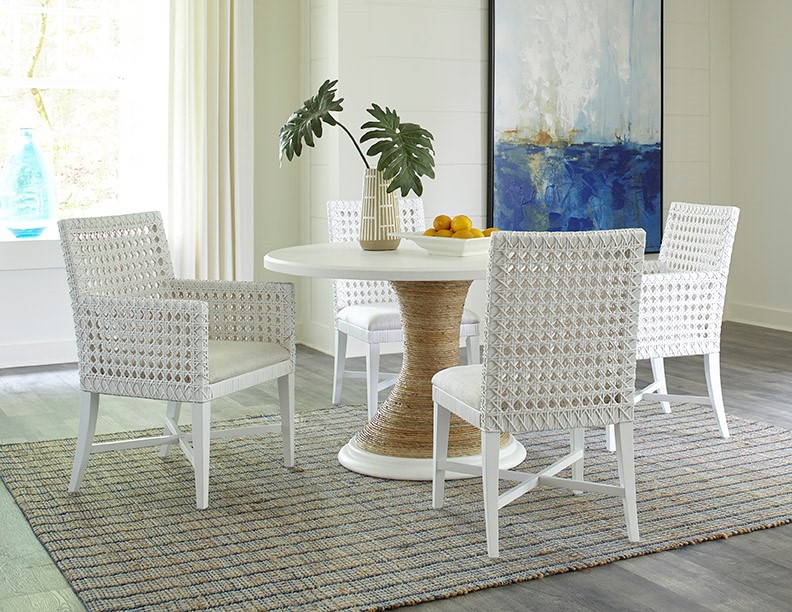And other takeaways from the June High Point Market
HIGH POINT — There’s a movement afoot for a U.S. anti-dumping petition against producers of upholstery from Vietnam.
It’s not a sure thing, but there was enough talk going on about it during the just concluded High Point Market that it was the first thing City Furniture’s Keith Koenig said to us during an interview here.
If it happens, “it would be challenging for everybody in the industry,” said the CEO of Tamarac, Fla.-based Top 100 company, who stopped for a brief chat in front of Showplace. “I’m having suppliers ask me about my opinions, which is, obviously, I don’t feel that would be helpful for anybody in the industry, especially when supply chains are constrained the way they are.”

According to more than one source, the potential move stems from what’s happening in Canada, where some upholstery producers in Vietnam and China are now subject to largely prohibitive duties. For Vietnamese producers, the rate is 101.5% for all except seven companies assessed lower duties that range from 17.4% to 89.8%. For Chinese producers, the duties for some topped 200%.
A final determination is expected by the Canada Border Services Agency in early August, and according to one source who asked not to be identified, that’s what a group of US. producers is monitoring closely to see whether or not a petition here would be worth it. They want to see if the move in Canada, led by Palliser, succeeds in blocking alleged unfair competition with standing prohibitive duties. But they’re also weighing the potential fallout with their own retail customers should they move on a petition of their own.
“They learned from the (antidumping duties) on Chinese bedroom furniture that things can get ugly pretty quick,” the source said.
Here are a few other takeaways from conversations in High Point
We’re not back to normal yet but no complaints. This was the industry’s first maskless market, and while traffic clearly wasn’t what we were used to seeing pre-pandemic it was better than some expected. One concern going into market was the biggest players who came in droves during the April Premarket wouldn’t be back. Indeed, many of the retailers in question told us that would be the case.
But many others came — City, obviously, but also Nebraska Furniture Mart. WG&R, Kittle’s, Furniture Mart USA, a lot of them. Jofran CEO Joff Roy went as far as to characterize the June Market as “the best ever,” noting early on in the cycle attendance was running at least 40% ahead of Premarket levels.
But when Roy calls this the “best ever,” he’s not talking so much about total numbers of buyers walking through the door as what they mean “in terms of what will grow from this, the feedback and the new customers that have come in.
“The pandemic has created such disruption to the industry that for those that have an outstanding business model like we do, we’re picking up customer right and left — big ones, important, impactful customers.” (Jofran’s business model is “heavy inventory,” which has helped it keep retailers supplied during times of severe shortages, though Roy doesn’t deny the company is impacted by shipping and other pandemic-induced delays, too.)

“There are limited nice things about having markets five weeks apart, but actually having the time with buyers to be able to sit down and really talk about what is the status of our business and relationship and assortment plans .. and what can we all do better to make it work,’ has been rewarding.
Jamie Collins at Homelegance had a similar take. As far as attendance goes it was less than a normal market, but about what the company was expecting, and it did see a lot of its larger accounts.
“They were looking at product and giving us great feedback, which is what we wanted because we’ve had limited opportunity to show new producer … since March of 2020,” said the executive vice president of the whole home resource.
And what are retailers looking for? Asked if Koenig’s buying team was here looking more for what’s new or what’s available now, he said it’s both, “But our supply chain is global, so everything is programmed out. As suppliers have had to change price and freight costs have changed, you have to re-look at your whole lineup and see where the right price points are, make sure you’re competitive on everything. The cards kind of get thrown up in the air.
“Overall, he said, “we’re always looking to fill in where style trends are going and where we have some gaps in our lineup.” City’s lineup up is strong, and Koenig, who added he’s proud of his merchandising team, “the youngest team in the market,” but at the same time, there’s always opportunity.
What City specifically is going after here in a bigger way is what Koenig called “coastal modern” (think natural woven accents, light finishes modern lines) that ft the Florida coastal community in which it operates. One of his favorites in this vein (when I asked for an example) is Panama Jack’s Boca Grande, already on City floors, which gets to the heart of why many buyers are here

“Everybody knows the priority right now is to ship the product the retailer has already sold to their customers,” said Homelgance’s Collins. “So everybody is prioritizing existing product. We’re getting great feedback on what we brought out that’s new, but everybody knows that that newness is not going to be on the floor until well into the future.”
About those container prices. Could it get any worse? Yes, it can and it is. We’ve heard $19,000 and $20,000 thrown around this market, depending on where it’s coming from and where it’s shipped to. Think about that for a second. As one supplier explained to me, a $20,000 container to the East Coast works out to $8.50 per cube. A little over a year ago, the cost was less than $2 a cube. Yes, margins were thin for the shippers back then, “but they were still operating,” the source said.
It doesn’t sound like City Furniture has had to pay that much yet, but its container prices are still up there, even though the retailer has good contracts in place for much of what it needs to move. But here’s the problem: many other retailers, who don’t have contracts are waiting for inventory. They can move it at the exorbitant spots rates we’re all hearing about (if they can secure space on a ship) but in many cases, it doesn’t just make sense to do it because they can’t make it up the price on these already sold goods and would end up losing money.
So they wait it out, hoping container prices will fall, which creates more headaches on the production end, where there’s not enough space to store all the goods waiting for pick up (without additional expense). It’s a mess Koenig said he doesn’t want to contribute to.

“We have an outstanding order with all of our supply chain team that we move the goods no matter what,” he said. “If we have to pay the price, we have to pay the price, because we have to be a good partner for our suppliers.”
The final and best takeaway: “The best thing about the market is it re-energized everybody who’s here,” Collins said.
“We’ve all been working from home. We haven’t been traveling. We’ve been trying to do Zoom meetings and conference calls and developing product from a photograph on a computer, and it’s just not what we’re used to doing,” he said.
“So to be back at a market, working with retailers, talking about product and looking to the future, it’s energizing at a level I think we all need.”




